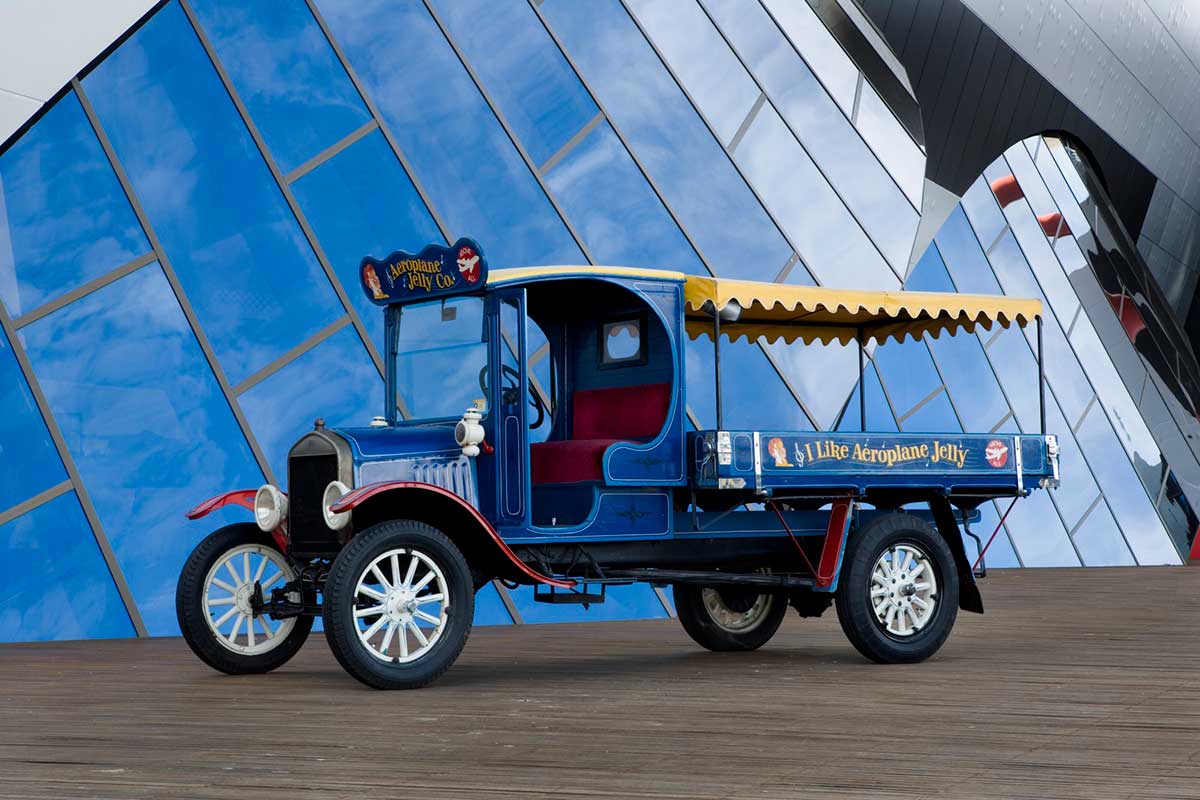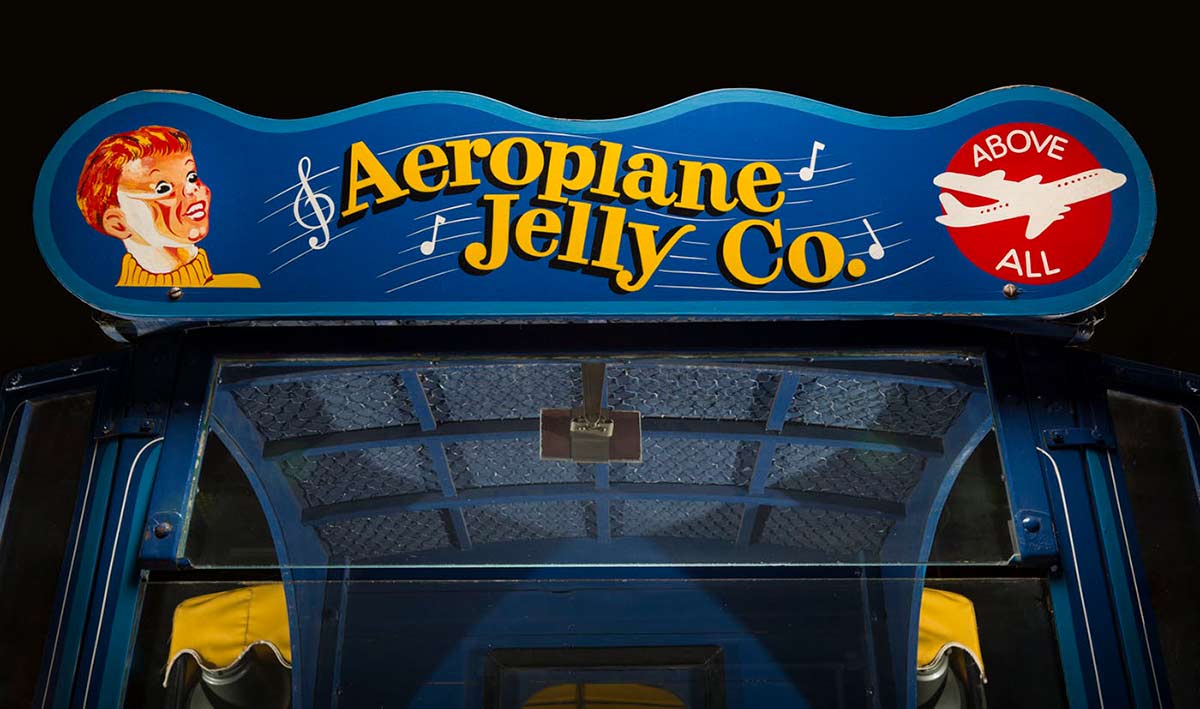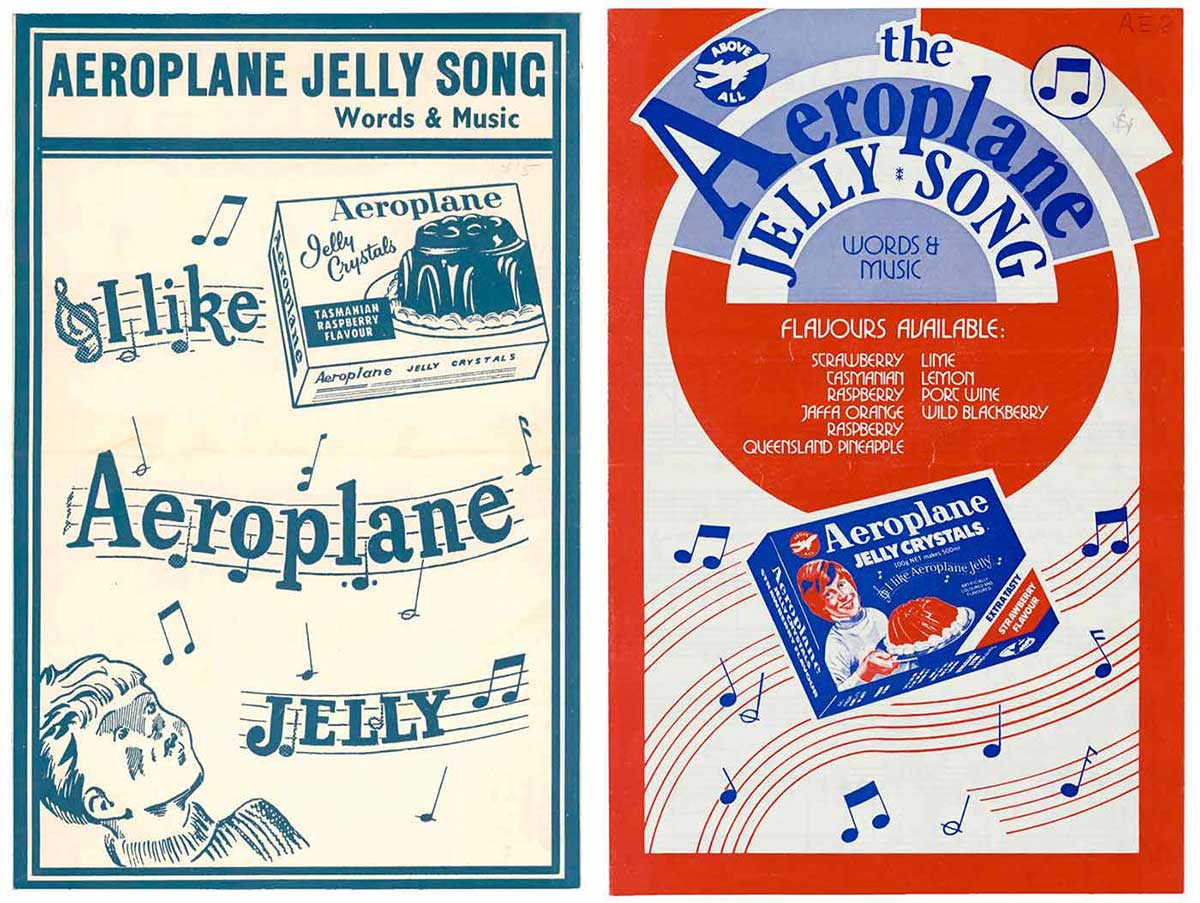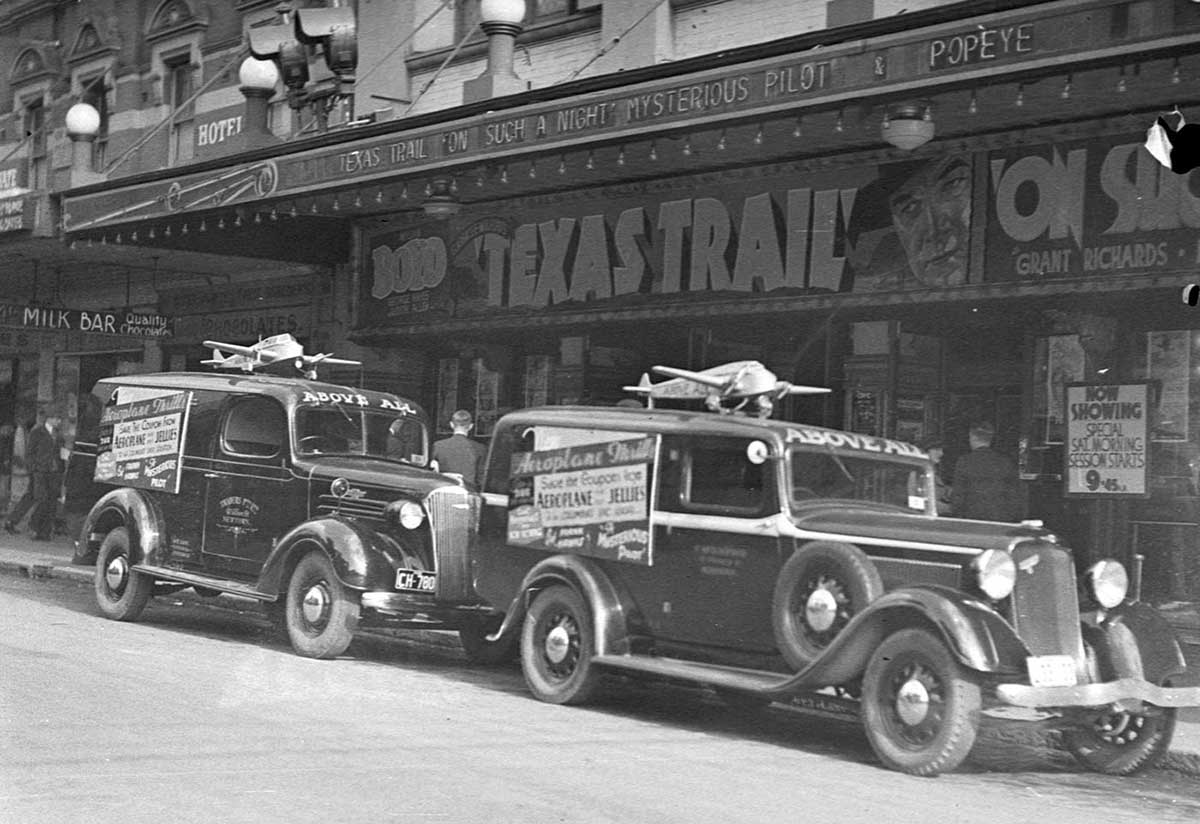A 1920s Model-T Ford truck used to promote Aeroplane Jelly once loudly broadcasted the Aeroplane Jelly jingle at food fairs and other promotional events.
Aeroplane Jelly history
Aeroplane Jelly began in 1927 after Sydney tram driver Bert Appleroth had success selling jelly crystals first made in a bathtub.
This small backyard operation had evolved into one of Australia's largest family-operated food manufacturers when it was sold to McCormick Foods Australia in 1995.
Jelly crystals
Adolphus Herbert 'Bert' Appleroth (1886–1952) was working as a tram driver in Sydney when he began experimenting with the production of jelly crystals in about 1905. The sugar and gelatine were mixed in the bathtub of his parent's house in Paddington. Appleroth then sold and delivered the crystals door to door.
In 1926 Appleroth formed a partnership with Albert Francis Lenertz, who owned a wholesale grocery and spirits business. The Traders Ltd partnership marketed the jelly crystals under the name 'De-Luxe'.
The following year they re-launched the product as 'Aeroplane Jelly' – a name that sought to tap into the excitement and glamour of modern aviation.
Appleroth and Lenertz
Appleroth created the company's trademark 'Above All' but it was Lenertz who wrote the words and music to the Aeroplane Jelly song that became Australia's longest-running advertising jingle. Lenertz left the company in 1934 but the Appleroth family continued the business through three generations.
By the mid-1980s the company was producing about 35 million packets of jelly crystals a year and controlled about half the Australian market, with an estimated value of $15 million.
Advertising jingle
Few advertising jingles in Australia are as widely known or as long-lived as the Aeroplane Jelly song, penned by Albert Lenertz in 1930. He originally wrote the piece as a political tribute to Australian Prime Minister William Morris Hughes. It featured lines such as 'Folk in the city and folk on the plain, Billy's great deeds for our land can acclaim'.
The song had a far greater impact in its second iteration as the Aeroplane Jelly jingle. The tune has become as much a part of Australian folklore as the FJ Holden, lamingtons and vegemite. An example of what we now call 'saturation advertising', in the 1940s the song is said to have been broadcast on radio more than 100 times a day.
The song was initially recorded by child imitator Amy Rochelle in about 1930. In 1938 it was re-recorded by five-year-old Joy King, chosen as the result of a competition. Tommy Dawes was runner-up in the competition and a likeness of his face appeared on Aeroplane Jelly's packaging as the 'whistling boy' for many years.
Aeroplane Jelly song lyrics
Words and music by Albert Francis Lenertz, 1930
I’ve got a song that won’t take very long,
And a good sort of note if I strike it.
It is something we eat, and I think it’s quite sweet,
And I know you are going to like it.
I like Aeroplane Jelly … Aeroplane Jelly for me,
I like it for dinner, I like it for tea,
A little each day is a good recipe.
The quality’s high as the name will imply,
And it’s made from pure fruit, one more good reason why
I like Aeroplane Jelly … Aeroplane Jelly for me.
I like Aeroplane Jelly … Aeroplane Jelly for me.
Marketing schemes
Appleroth had many innovative ideas for promotional and marketing schemes. In 1934, the company chartered a Tiger Moth biplane, had it painted with the Aeroplane Jelly logo and delivered their product to rural areas. The company sponsored broadcasts from Goulburn gaol in the late 1940s that ended with a rowdy cry from prisoners to 'buy Aeroplane Jelly'.
By the late 1940s the company was investing about £13,000 in advertising each year. These advertising tactics proved to be highly successful. By 1949 annual turnover was about £170,000.
The company created a new mascot for its product. Bertie the Aeroplane, named after Appleroth, in the 1940s. Bertie featured on packaging and in a range of popular cinema advertisements.
Appleroth died in 1952, but the company continued to promote its product in fun and inventive ways.
In 1978 Appleroth's grandson, Bert III, sponsored the Aeroplane Jelly Air Race from Brisbane to Sydney as part of the commemoration of Charles Kingsford Smith's trans-Pacific flight. Another unusual promotional stunt involved 35 people diving into a pool filled with 35,000 litres of watermelon-flavoured jelly.
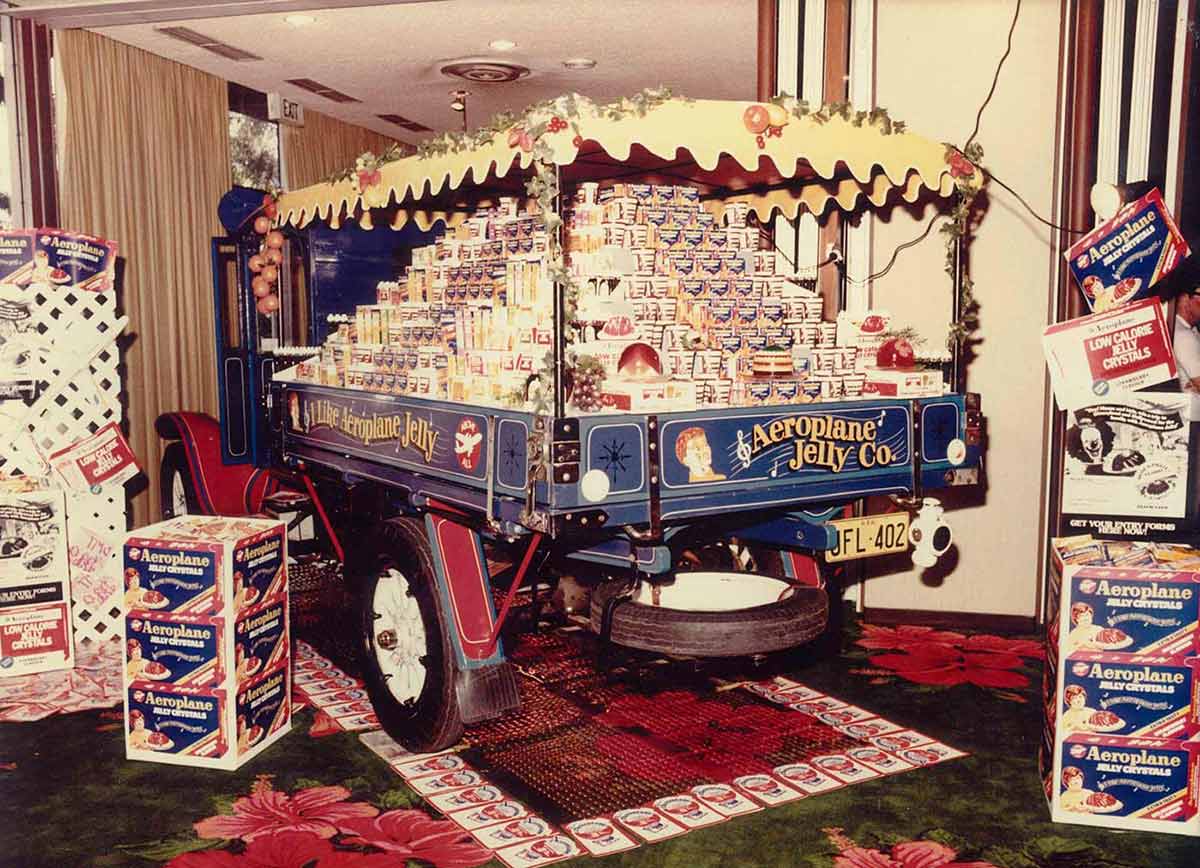
Aeroplane Jelly truck
Throughout the company's history a range of promotional vehicles were used to carry Aeroplane Jelly slogans and products across the country.
The Ford Model-T in the National Museum's collection has a 1924 engine and a 1925–26 body. The Model T, also called the T-Model, was produced in America until 1927.
This truck was used to promote Aeroplane Jelly from 1978 to 1988. Emblazoned with logos and loudly broadcasting the Aeroplane Jelly jingle, it was a common sight at food fairs and other promotional events throughout the 1980s.
Aeroplane Jelly was acquired by the Baltimore-based McCormick Foods Australia in 1995, ending the Appleroth family's 70-year association with the company started by Bert. McCormick Foods Australia donated the truck to the National Museum in 2002.
The truck was on show at the Canberra Airport in 2015.
In our collection
